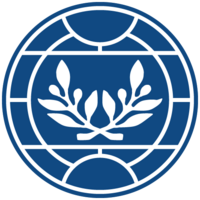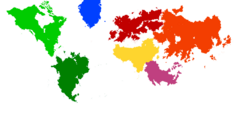Ajax: Difference between revisions
m (→List of Nations in Ajax: Edited Tyreseian government type) |
|||
| Line 310: | Line 310: | ||
| New Tyria City | | New Tyria City | ||
| 33,275,404 | | 33,275,404 | ||
| [[wikipedia:Syndicalism| | | [[wikipedia:Federation|Federal]] [[wikipedia:Syndicalism|syndicalist]] [[wikipedia:Directorial_system|directorial]] [[Participism|council republic]] | ||
|- | |- | ||
| '''{{flag|Uluujol}}''' – Khaganate of Uluujol | | '''{{flag|Uluujol}}''' – Khaganate of Uluujol | ||
Revision as of 03:53, 4 March 2022
This article is incomplete because it is pending further input from participants, or it is a work-in-progress by one author. Please comment on this article's talk page to share your input, comments and questions. Note: To contribute to this article, you may need to seek help from the author(s) of this page. |
 | |
| Demonym | Global Worldwide International |
|---|---|
| Countries | 47 (several disputed) |
The world is the combination of the planet and all the life on it. In the context of humanity, the world references the entire collective of human civilization, including all nations, peoples, and societies. It is made up of 7 continents and 5 oceans, containing at least 47 nations.
Continents

Belisaria
Belisaria is a continent located on the Northern Hemisphere, northeast of the Global Center. It is surrounded, clockwise from the North, by the Boreios Sea, the fellow continent Ochran by land, the Periclean Sea, the Salacian Ocean, and the Sea of Ghant. It is the western part of the Belisario-Ochrani supercontinent. It is divided from Ochran through the TBD Mountains in its east, and through continuous waterways from the TBA Sea, flowing into the Periclean Sea through to the Salacian Ocean.
It is the fourth largest continent, eclipsed in size by Ochran, Norumbia, and Oxidentale. Its political geography is divided between 18 sovereign nations. Some of its largest states include North Ottonia, Latium, Lihnidos, and Arthurista. Collectively, the Belisarian nations have a population of approximately one billion people. The Belisarian climate, given much of the continent is in the higher latitudes and due to Salacian oceanic wind currents is colder and drier, especially in the northwest and north/far north. It is more temperate and cool-to-warm in the central, inland regions of the continent. In the far south along the Periclean coast, it is warm-to-hot, with mild, rainy winters and hot, semi-humid summers.
Belisaria is the birthplace of Hellenic and Latin civilizations in antiquity. Well into ancient history, it had trade and documented ties to Scipia, western Ochran, Ghant, and disputably Norumbia. During the medieval period, the Christianization of Belisaria from former Latinic lands in the south of the continent north and eastward introduced new social values and economic development, while the continental states slowly centralized over the centuries from fractured fiefdoms and small kingdoms into larger empires and trans-continental powers. By the early modern period, exploration, art, and scientific revolutions led to blossoming political ties and trade networks abroad, including the Jade Road in Ochran, the Northern Scipian coastal states, and religious and exploratory expeditions into Norumbia and beyond.
The 18th, 19th, and early 20th century was characterized by rising nationalism, modernization, and industrialization, including a number of revolutions and wars. In late modernity, Belisaria saw an emerging geopolitical status quo of peace and restraint of use of arms. Currently, the continent enjoys an era of prosperity and stronger intrastate relations.
Ghant
The continent of Ghant is comprised solely of the nation of Ghant, just west of the Global Center of the Northern Hemisphere. It's surrounded, clockwise from the North, by the northern polar ice regions, the Borleis Sea, the Sea of Ghant, and the Salacian Ocean. It is approximately equidistant between Norumbia and Belisaria. It is the smallest continent, narrowly smaller than Malaio.
The continent-nation of Ghant has a population of approximately 55.5 million. Ghant has a subarctic climate, with long, usually very cold winters, and short, cool to mild summers. Temperatures vary greatly from north to south, with the southern areas having more balanced, temperate seasons then the north.
Ghant is home to the Ghantish culture, a unique and remote society unlike any other, despite later religious and social ties to Belisaria and parts of Norumbia. It is one of the so-called "cradles of civilizations," with a written and oral history dating back perhaps up to 12,000 years old. The continent has folklore and customs dating to antiquity that discuss early kingdoms and alleged supernatural elements in Ghantish prehistory. The historical record suggests the first Ghantish civilization originated in the far south and developed northward over thousands of years. Cold weather, rugged terrain, and uneven crop-growing soil fractured early Ghantish petty states and fiefdoms. By the middle of the medieval period, the first Ghantish state of some power, Kingdom of Low Ghant, in southern Ghant emerged, and developed extensive ties to other fiefdoms to its north and to both Belisaria and Norumbia. Low Ghant's throne was inherited by a Belisarian Ottonian dynasty, which caused political and social tumult. Alongside this, the Black Death hit the continent, causing great population loss and social upheaval.
The continent suffered next under a series of religious wars in the late medieval and early modern era, with conflicting local pagans, Fabrian Catholics, and Protestant Christians all trying to lay claim to Ghantish society. King Samuel V of Low Ghant in the 17th century was crowned the first "King of Ghant" and reconciled the religious divide, as well as pressing north (continued by his descendants) to absorb more independent kingdoms under Low Ghant's rule, which comprised most of the 18th century. In the late 18th and early 19th centuries, Ghant underwent the Industrial Revolution, aided by the unification of the whole continent in 1800 under Nathan I, who took the title Emperor. The century and a half from the dawn of the 19th century until the middle of the 20th century was characterized by numerous civil wars and conflicts between the centralizing monarchy in the south and local "Great Lords" in the center and north of the country.
In the later years of the 20th century and into the 21st century, Ghant has become a settled nation, increasingly looking outwards. Despite its more recent domestic calm and prosperity, it still maintains uneven development by modern standards, with the north in many places still reflecting an almost medieval state of being while the south and coasts are modern and urbanized. It has developed extensive oil deposits inside its borders, becoming a petrostate. Its recent elected leaders have emphasized human rights and self-determination.
Ochran
Oxidentale
The term Oxidentale is derived from early Rezese and means "Western" which is how Rezese have seen the continent for centuries, contrasting the "East" as being Scipia and Belisaria (whose people are generally known locally as Latins). The peoples of Oxidentale were the first to establish contact between the continent and various peoples in Scipia and Belisaria, leading to early trade ties as well as the development of the creole language and culture of the Rezese. Its largest nations are the Mutul and Sante Reze, the former being one of the largest empires in history alongside Latium and the latter establishing trade posts and economic dominance across the Oorupaqi. The nation of Zacapican has also spread throughout the world in its history, establishing colonies and trade ports in southern Malaio.
Oxidentale is home to the largest rainforest in the world, which has powered an advanced pharmaceutical industry, as well as many of the largest corporations in the world. The nations of Oxidentale have long built their empires and relations along the basis of trade, and continue to do so to this day. They have also been at the forefront of technological advancement, particularly in energy solutions and electronics. The total population of the continent is approximately 420 million, with most of these living in the coastal regions.
Malaio
Malaio is the moniker given to the landmass connected to the southeast of mainland Scipia, with the boundary internationally recognized at the geographically separating (Insert mountain or river). The area hosts a history of colonial engagement and indigenously developed authority- with modern states versed heavily in maritime tradition due to their proximity to the Ozeros Sea. Because of its location close to historically important trade routes, the region has seen early and prolonged contact with nations from Belisaria, Ochran, Scipia and Oxidentale. Therefore, religious and sociocultural traits and inspirations from all four continents find different extents of integration into the region, with many smaller communities now proliferating in modern Malaio.
Malaio has a population of approximately 170 million. There is a tropical climate throughout the continent, especially within the coastal regions- with a recognizably long cycle of wet and dry seasons that contribute to the rich biodiverse environments within the region.
Two modern states compose the larger, internationally involved representatives of Malaio- both existing at the mouth of the Ozeros Sea- and thus are largely historically tied to larger global phenomena- such as the expanse of Mutulese Ochran, historical conflict between the Tahamaja thalassocracy and Bayarid khannate, and a more recent boom of international cooperation, such as within the Kiso Pact, and the development of the Association of Malaio Ozeros Nations(AMON).
Pulau Keramat consists of the northernmost peninsula and archipelago of Malaio, sharing a southern maritime border with Onekawa-Nukanoa, and being separated via the northern Ozeros strait to much of the Southern Ochrani states. The Confederated Oligarchical Republic was known for helping stabilize contact with the region after historical regionalistically-fueled nationalistic sentiments had characterized the area in years past. The nation has an intricate system to the separation of powers, with each of the member nations holding their own elections, as well as supranational elections and technocratically-based exams held for the Dewan Emas, a council of six that hold executive decision-making prowess over the nation. Some important resources of the nation include various maritime products, shipbuilding, fabrics and numerous agricultural industries, as well as serving as an enormous port and center for reshipping and re exporting goods between the Vespanian and Ozeros Seas, seeing extensive development in economic complexity as the confederacy has initiated trade via interregional organizations and other partnerships. In addition, the N’nhivaran faith is known to originate from the Pulaui Archipelago- a faith that has received contentious reaction in it’s own ties to some of the confederate states and their governing structures, as well as the spread of the faith to the international setting, given it’s deliriant practices, with the extent of some rituals being admonished by larger health organizations.
Onekawa-Nukanoa is situated at the easternmost peninsula of Malaio and shares a western land border with [X]. Ngāti Onekawa-Nukanoa's population is dominantly the indigenous Maori, but is known to have a culturally, ethnically and religiously diverse, representing much of Malaio and southern Ochran as a result of an extensive history of colonization by outside powers dating as early as the 10th century. A militaristic, absolute federal monarchy composed of six iwi unified under the rule of the Māori Kingi; each subordinate to the federal executive, legislature and judiciary, with their own royal families and governments. An extensive heavy industrial sector forms the backbone of economic activity, including aerospace development, alongside important secondary industries such as agriculture, aquaculture and forestry. Home to an extensive biodiversity with birds filling many of the roles of mammals on other continents, with a number of endemic species such as Moa, Tamawhiro and Pouakai.
